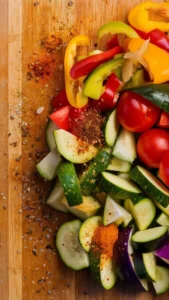Introduction:
Fruit and vegetable peels are often overlooked but are packed with nutrients and health benefits. In this comprehensive guide, we’ll delve into the advantages of eating peels, their impact on the environment, and easy ways to incorporate them into your diet.
1. Nutrient-Rich Peels:
Fruit and vegetable peels are nutrient powerhouses, containing high levels of vitamins, minerals, and antioxidants. For example, apple peels are rich in vitamin C and dietary fiber, while orange peels contain flavonoids and other phytochemicals. By consuming the peel along with the fruit or vegetable, you can significantly boost your nutrient intake.

2. Health Benefits of Peels:
Numerous studies have highlighted the health benefits of eating fruit and vegetable peels. These benefits include improved digestion, better heart health, and even a reduced risk of certain cancers. The antioxidants found in peels can also help protect against oxidative stress and inflammation, which are linked to various chronic diseases.

3. Environmental Impact:
By eating fruit and vegetable peels, you can help reduce food waste and its environmental impact. Food waste contributes to methane emissions in landfills, which are a significant driver of climate change. By using the entire fruit or vegetable, you can play a part in reducing these emissions and promoting sustainability.
4. Simple Ways to Eat Peels:
Incorporating peels into your diet can be easy and delicious. Try adding citrus zest to salads or marinades for a burst of flavor. You can also roast potato skins with olive oil and spices for a crispy snack. Be creative and experiment with different fruits and vegetables to find new ways to enjoy their peels.

5. Advantages and Disadvantages of Eating Peels: Advantages:
- High nutrient content: Peels are rich in vitamins, minerals, and antioxidants.
- Environmental impact: Eating peels reduces food waste and promotes sustainability.
- Cost-effective: Using the entire fruit or vegetable maximizes your purchase.
- Versatility: Peels can be incorporated into a wide range of dishes.
Disadvantages:
- Pesticide residues: Peels may contain pesticide residues, so it’s important to wash them thoroughly.
- Texture and taste: Some people may find the texture or taste of certain peels unappealing.
- Allergies and sensitivities: Individuals with food allergies or sensitivities should be cautious when consuming peels.
6. Conclusion:
In conclusion, fruit and vegetable peels are nutritious, flavorful, and environmentally friendly. By incorporating them into your diet, you can enjoy their many health benefits while reducing food waste. With a bit of creativity, you can turn peels into tasty additions to your meals and snacks.
Call to Action:
Ready to reap the rewards of fruit and vegetable peels? Try incorporating them into one meal per day for a week and see how you feel. Share your experience with friends and family to spread the word about the benefits of peels.















+ There are no comments
Add yours